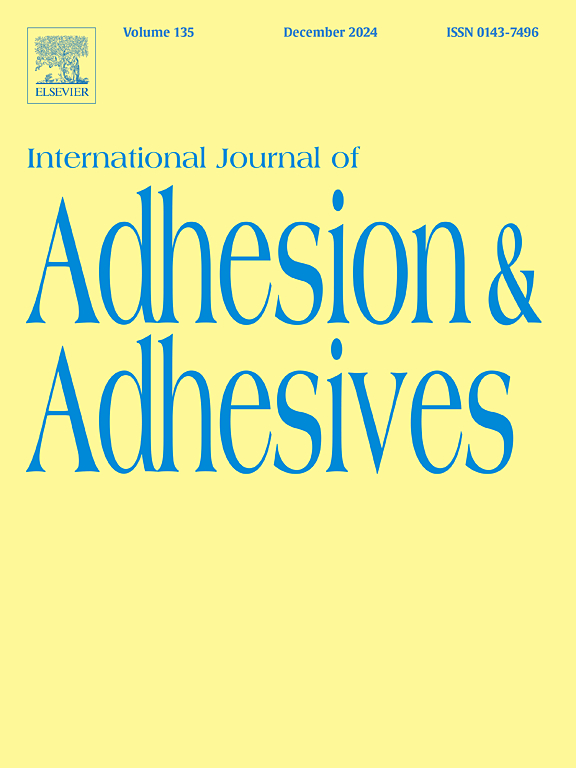再矿化剂应用方式对侵蚀牙本质形态及结合强度的影响
IF 3.5
3区 材料科学
Q2 ENGINEERING, CHEMICAL
International Journal of Adhesion and Adhesives
Pub Date : 2025-05-17
DOI:10.1016/j.ijadhadh.2025.104065
引用次数: 0
摘要
目的评价再矿化剂(MI Paste Plus Recaldent和clinpro5000)不同应用方式对牙本质小管咬合、表面组成及通用粘接剂系统与侵蚀牙本质结合强度的影响。材料与方法120只牛牙齿切片暴露牙本质,进行15天的腐蚀试验。根据再矿化策略将标本分为5组(n = 25):被动或主动应用MI Paste Plus Recaldent,被动或主动应用Clinpro 5000,以及对照组(不进行治疗)。采用自蚀刻策略,采用Scotchbond通用胶粘剂体系。使用扫描电镜评估牙本质小管闭塞和沉淀形成,而EDX分析确定元素组成。测量了微拉伸粘结强度,并对失效模式进行了分类。结果与对照组相比,积极应用MI Paste + Recaldent改善了牙本质小管咬合和结合强度(p <;0.05)。被动应用Clinpro 5000时,小管闭塞程度最高;然而,它的积极应用促进了氟的沉积,但降低了键强度(p <;0.05)。在表面残留物沉淀方面,各组间无差异(p >;0.05)。所有组均以混合性失败为主。EDX分析仅在clinpro5000的主动应用中检测到氟化物和降低的Ca/P比率。结论再矿化剂对牙本质小管咬合和结合强度的影响与材料和使用方法有关。MI Paste Plus在主动应用时效果更好,而Clinpro 5000在被动应用时效果更好。本文章由计算机程序翻译,如有差异,请以英文原文为准。
Effect of application methods of remineralizing agents on morphology and bond strength to eroded dentin
Purpose
To evaluate the effect of different application methods of remineralizing agents (MI Paste Plus Recaldent and Clinpro 5000) on dentinal tubule occlusion, surface composition, and the bond strength of a universal adhesive system to eroded dentin.
Materials and methods
One hundred and twenty bovine teeth were sectioned to expose dentin and subjected to a 15-day erosive challenge. Specimens were divided into five groups (n = 25) based on the remineralization strategy: passive or active application of MI Paste Plus Recaldent, passive or active application of Clinpro 5000, and a control group (no treatment). Scotchbond Universal adhesive system was applied using the self-etch strategy. Dentinal tubule occlusion and precipitate formation were assessed using scanning electron microscopy, while EDX analysis determined elemental composition. Microtensile bond strength was measured, and failure modes were classified.
Results
Active application of MI Paste Plus Recaldent improved dentinal tubule occlusion and bond strength compared to the control group (p < 0.05). Passive application of Clinpro 5000 showed the highest tubule occlusion; however, its active application promoted fluoride deposition but decreased bond strength (p < 0.05). No differences were observed among groups regarding surface residue precipitation (p > 0.05). Mixed failure was predominant in all groups. EDX analysis detected fluoride and reduced Ca/P ration only in the active application of Clinpro 5000.
Conclusion
The effects of remineralizing agents on dentin tubule occlusion and bond strength depend on both the material and the application method. MI Paste Plus was more effective with active application, while Clinpro 5000 showed better results with passive application.
求助全文
通过发布文献求助,成功后即可免费获取论文全文。
去求助
来源期刊

International Journal of Adhesion and Adhesives
工程技术-材料科学:综合
CiteScore
6.90
自引率
8.80%
发文量
200
审稿时长
8.3 months
期刊介绍:
The International Journal of Adhesion and Adhesives draws together the many aspects of the science and technology of adhesive materials, from fundamental research and development work to industrial applications. Subject areas covered include: interfacial interactions, surface chemistry, methods of testing, accumulation of test data on physical and mechanical properties, environmental effects, new adhesive materials, sealants, design of bonded joints, and manufacturing technology.
 求助内容:
求助内容: 应助结果提醒方式:
应助结果提醒方式:


